Chris & Allyson vs. California (2014)
Day Five: Hearst Castle. More driving. A surprise at Ventura Pier. Santa Monica.
America is fine country with one glaring deficiency: It experienced very little siege warfare before the 19th century. As a result, we have almost no castles, which are widely recognized as the greatest of all man-made structures. Cathedrals are nice, and skyscrapers have some aesthetic appeal, but only castles have something called a "murder hole."
There's no way to fix this problem -- we're a forward-thinking nation, and castles just don't make economic sense in the modern world, no matter how many people you would like to pour boiling tar on. But a handful of our greatest private citizens have done their best to ease the pain.
Hearst Castle has no defensive walls, no keep, no dungeon and no moat. They built no arrow slits into the walls, nor is there a murder hole anywhere on the grounds. But it is a ridiculous mansion -- among the finest you can tour -- and we woke up four miles from the gate.
What a lucky coincidence that I happen to love mansion tours! More importantly, at some point I brainwashed my wife to feel the same way. It wasn't a particularly hard sell to get Allyson interested in the Winchester Mystery House, and she put up no resistance to Hearst Castle -- even though she visited as a teenager. There are three possibilities:
1) Allyson feels that my presence adds so much value that it's like experiencing the world anew.
2) Allyson feels that I will be such an unbearable b***h if I don't get my way that she fakes enthusiasm.
3) Allyson is banking all these things away for a huge quid pro quo, whereupon we go on a two-week theme cruise with the aging music stars of the New Wave era.
I can live with any of these, as long as the cruise is all-inclusive.
William Randolph Hearst made his money the old fashioned way: He inherited it. His father (a senator during the Gilded Age) had some mining interests and a disturbing amount of land. One parcel was a ginormous ranch on hills near San Simeon, and the family went camping there on a regular basis. William liked it there.
When he came of age, William set out to become his own man, the old fashioned way: He took over the management of a San Francisco newspaper that his dad owned. Before long, he was running a chain of newspapers, including one of the biggest papers in New York. His journalistic exploits were legendary -- some people credit Hearst and Joseph Pulitzer with starting the Spanish-American War, which is a nice thing to put on your resume. He served a few terms in Congress, and he lost a few more political campaigns along the way.
When he gave up on politics, and on his marriage, he moved back to California. Hearst decided to shack up with his mistress, the movie star Marion Davies. He was William Randolph F***** Hearst, so naturally he couldn't use an actual shack. Hearst hired Julia Sand, a lady architect from San Francisco, to design an obscene home on the site of the old family camping grounds. Hearst and Sand never finished the job -- they only had a few decades to work on it before Hearst died -- but you can kind of see where they were going.
The castle is high atop a coastal hill. It takes about 10 minutes to cruise up in a shuttle bus, following the old horse trails. To this day, you can spy cattle grazing on the hillsides, because the Hearst family still operates the surrounding land as a ranch. There are also zebras running around, because Hearst was a very considerate host. Standard etiquette dictates that when you invite guests to your sky palace for week-long visits, it's not enough to provide luxurious lodging and regular meals. You also must entertain them, and for that purpose, Hearst had a zoo. Some animals roamed around in fenced enclosures next to the road -- the zebras are a remnant of that experiment. There was also a small pavilion for the careful management of animals that might eat your guests. If you're wondering just how rich Hearst was, remember: He had polar bears. Most animals were donated to proper zoos during the Great Depression, when Hearst started racking up debts. Everyone in the country was making sacrifices, and if you can't give up your giraffes in solidarity with the common man, then what kind of American are you?

Hearst Castle, one of America's most awesome private homes.
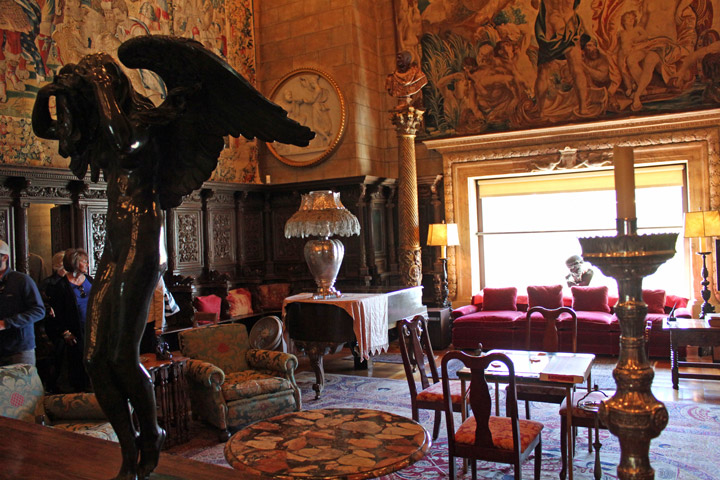
Hearst left no square inch of the common areas undecorated. This is pretty much the foyer.
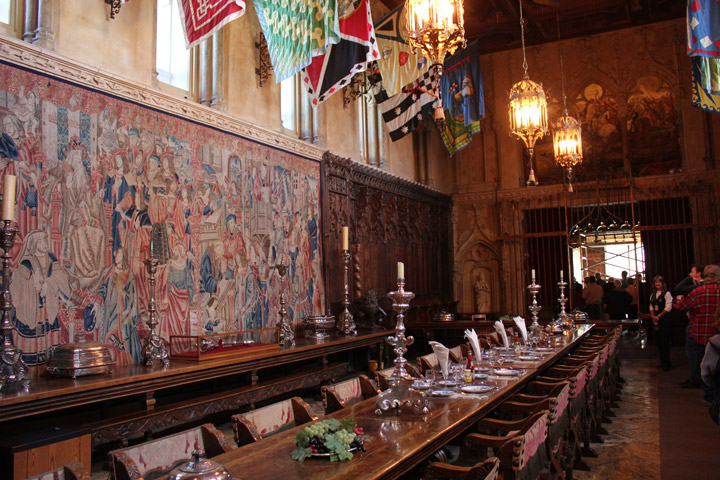
Where Hollywood stars would have dined, Medieval banquet style.
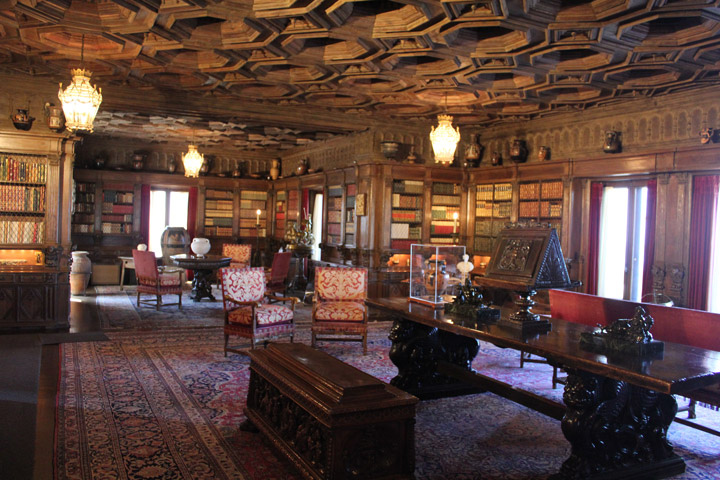
A library, and a great example of the floor-to-ceiling opulence of the castle.
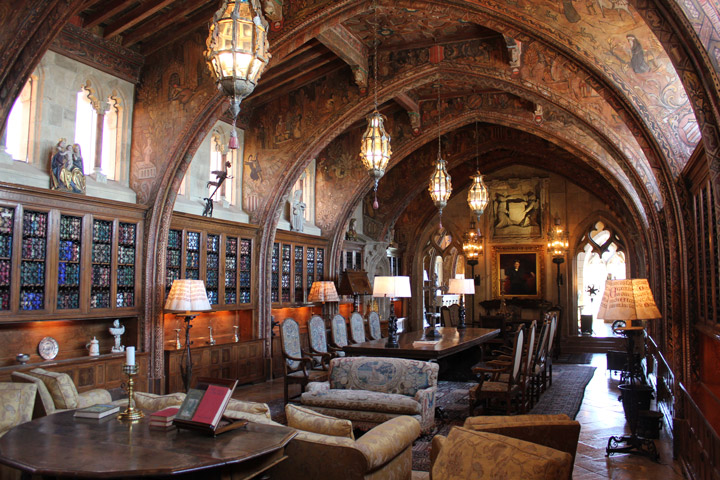
Step into Hearst's office.
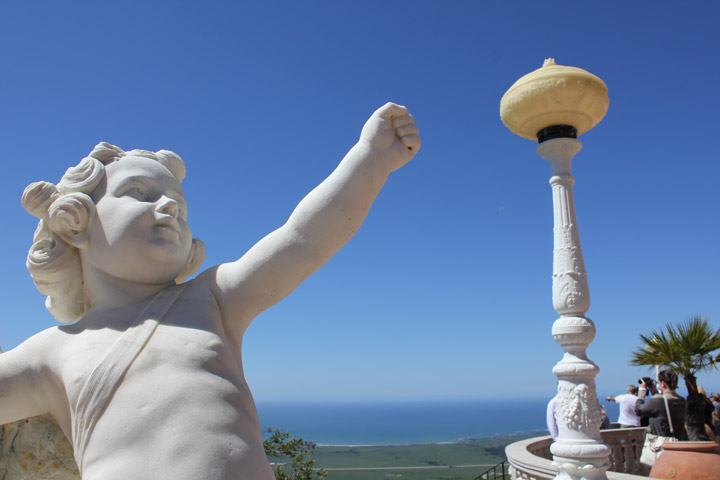
The decor at Hearst Castle isn't limited to the inside.
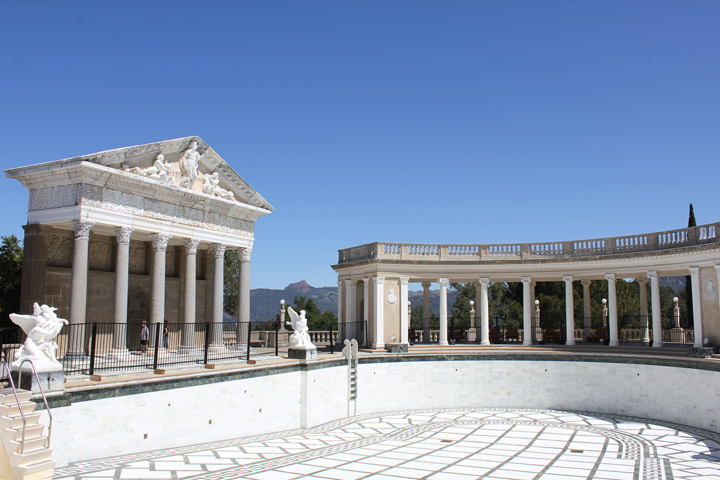
This pool was drained when we visited, but still pretty stunning.
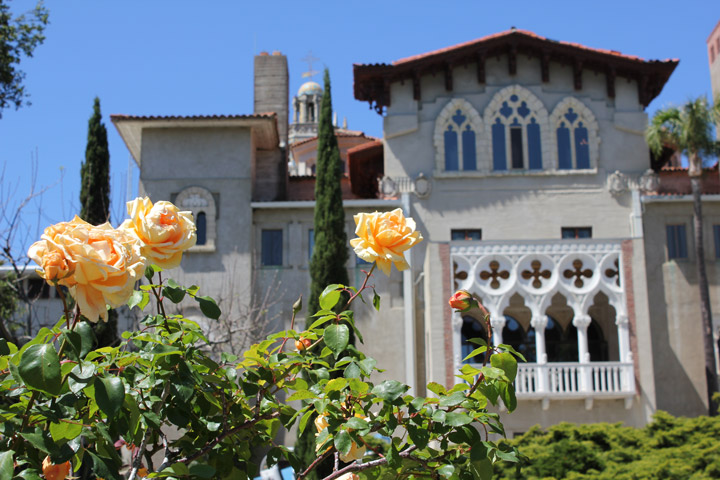
Another great view of one one of the building's finished sides.

The famous indoor pools at Hearst Castle.
The outside of the castle is an architectural mullet. The front looks like a Spanish cathedral, and the back looks like unfinished cement. We started our visit with the "Grand Rooms" tour, which focuses on the business in the front.
Hearst employed the "I Have Lots of Money" style of decorating. When Hearst was a child, his mom took him on tours of Europe, and even at a young age he snapped up art. He kept purchasing artifacts -- mostly Gothic -- and stashing them in warehouses, on the theory that you never know when you might need a Gothic artifact. He bought so much that he forgot what he had.
The castle was an excuse to remember. Hearst told Sand what he wanted out of his personal collection: pews from old churches, chandeliers from old castles, mantels from old villas, ridiculous antique furniture, etc. When the artifact was incorporated into a structural element, it didn't always fill the space. So they built more artifact. If a pew didn't run the full length of a wall, they made more pew, by hiring craftsmen who replicated the original. There were still plenty of tapestries, paintings a sculptures left over, so they just dumped them all over the building, like a grandma spreading around her Hummel figurines.
The first grand room is the Assembly Hall, where all the visitors would gather in the morning to socialize. Hearst regularly had movie stars, CEOs, politicians and other assorted geniuses staying at the castle, often in large groups. He had three rules for visitors: No embarrassing drunkenness, no dirty jokes, and (unless you're William Randolph Hearst) no having sex with anyone other than a spouse. Erroll Flynn was apparently asked to leave after half a day, but most people had open invitations to hang out.
The second grand room is the dining hall, featuring one of those long narrow banquet tables seen in cartoons about rich people. Hearst thought it promoted conversation. People might have talked about why the food was so lame. He insisted on simple fare, on the premise that the estate was just a glorified campground, so movie stars were all sitting around eating hamburgers. They also might have talked about the décor. The ceiling is a series of huge wood panels depicting the saints; it was supposed to be a placeholder until a proper gothic ceiling could be found. That one surface is probably worth more than any house I will ever live in.
The tour moves through the billiards room and ends in the movie theater, both of which are also grand. They show you just enough of the house to get you excited about paying another grand $25 fee for the Upstairs Suites tour.
Hearst had sleeping quarters built and decorated around common themes. There's a Venice suite (where H.G. Wells once stayed) and an innovative "duplex" room for the hot Hollywood bachelors. Starlets were matched up with roommates and stashed in small quarters in another part of the building, in the hopes of keeping them chaste. Hearst's suite is (surprise) gothic; he and Davies had separate rooms.
His private library had a stunning collection under lock and key -- guests were carefully supervised and couldn't take books from the room. His office has vaulted ceilings and looks like a good spot to meet a pope. The lampshades in Hearst's private spaces were made from old indentured servitude contracts, for some creepy reason. The only areas that aren't amazing are the stairwells and a few interior hallways -- in most cases, those are unfinished, undecorated concrete. It's bizarre how much they cared about some spaces and how little they cared about others.
The grounds ain't bad, either. There are palm trees and gardens and terraces and statues all around the edges. Lots of surfaces have mosaics, and on a clear day you can see the ocean. In addition to the castle, Hearst had three cottages on site. (One was his residence while the castle was under early construction.) There's a ridiculous Greek pool, surrounded by a temple-looking-thingy and some columns. There's a tennis court, and underneath that tennis court is a ridiculous indoor Roman pool, shimmering in gold and blue.
The whole place makes you very angry that your crappy parents never bought you a newspaper. Hearst has to be one of the strangest figures in American history. He had ties to the media, Hollywood, politics, the East Coast, the West Coast and Wales, where he owned an actual castle. He inspired "Citizen Kane," might have started a war and definitely rubbed elbows with most of the important people of the early 20th century. As mentioned earlier, he also owned polar bears.
We thought about all this while having lunch at a Mr. Pickle's sandwich shop in San Luis Obispo. Sometimes you need to cleanse the palate of your brain, and contemplating an anthropomorphic pickle mascot is a great way to do it. But then it was back on the road. We were done with the best part of the coast -- we took CA-154 into the mountains, where everything looks like an exterior shot from "Sons of Anarchy." The road eventually drops you back on the water at Santa Barbara.
There, for the first time in hundreds of miles, the road turns into ugly, crowded freeway. We weren't ready for ugly just yet, so we followed the signs for a "scenic coastal drive" when we reached Ventura. That gave us access to the Ventura Pier. It's billed as the longest wooden pier in the state, and we both knew that if we didn't see it, the regrets would haunt us and ultimately end our marriage.
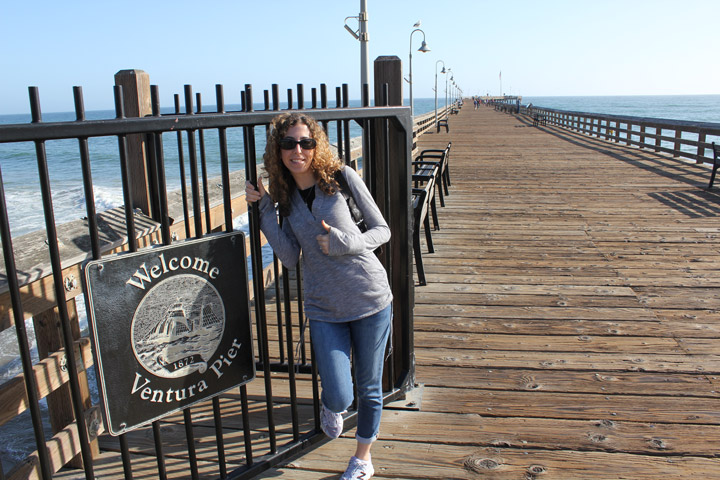
Ventura Pier, where we encountered a whale.
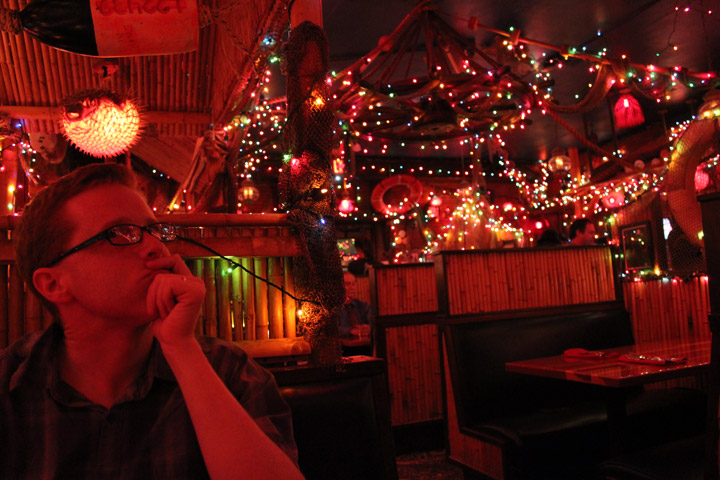
The very cool ambiance of The Galley, in Santa Monica.
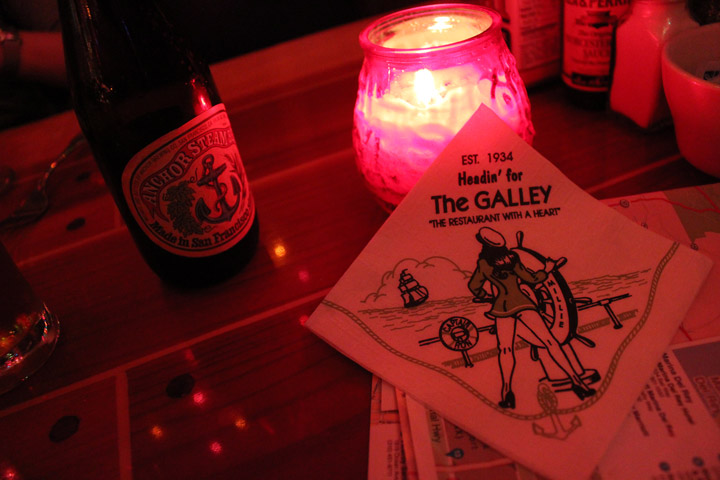
Even the napkins at the Galley are fun. Santa Monica.
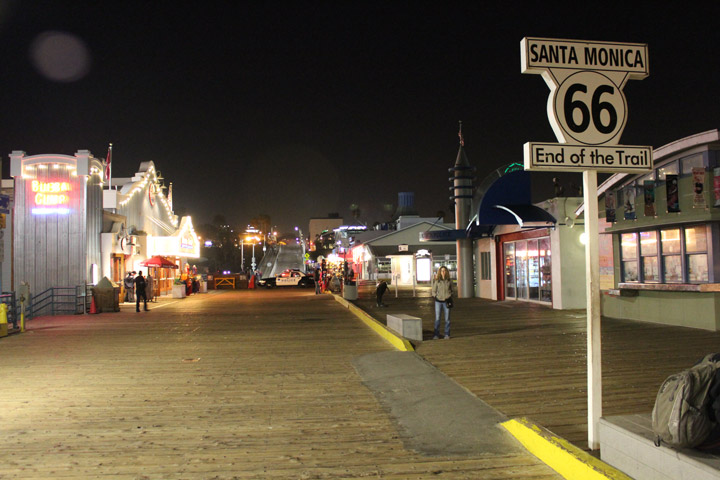
We got our kicks at the end of route 66. Santa Monica Pier.
It looks just like a wooden pier from New Jersey, but it points in the opposite direction. Piers are magical places. There was a time when they symbolized summer romance, idyllic fishing with a father figure and the mysterious intrigue of maritime commerce. Today, they're mostly a place for drunk people to hang out in the daytime, but there's still some of that old magic left. People near the end of the pier were gawking at something, and when we went to investigate, we saw gray whales popping in and out of the waves. After a few minutes, a school of dolphins showed up to the party. You would not get such a show at the second-longest wooden pier in California.
Back on the highway, we passed through Malibu, where very rich people have very nice houses on very pleasant beaches and cliffs. They will almost certainly be destroyed by the Big One. And as the sun was going down, we reached our destination for the evening. Santa Monica is a beach town, where the elite meet to discreetly beat the heat. It has rich people, poor people, and enough vegan juice bars to service both groups. Tourists have been flocking there for decades.
We're tourists, so we checked into a motel a few blocks from the beach. For dinner, we walked to the oldest restaurant in town. Opened in 1934, The Galley is a surf and turf joint with a nautical theme. Inside, it looks like a Christmas tree making out with a really nice Red Lobster. It's the kind of place that has "secret recipe" salad dressing and pictures of sexy ladies on the napkins. Jake Johannsen recommended it, even though my wife eats neither surf nor turf. But she's not a particular fan of juice cleanses either, so she toughed it out and had a piece of chicken. I gotta say I loved it.
We had a few hours until the eco-conscious vegan gangs of Santa Monica would take over the streets. So after dinner we decided to check out Santa Monica Pier. It could only be a disappointment after our gray whale love fest, but there's still some history behind it. It was the western terminus of historic Route 66, as well as a famous entertainment destination. It had the largest dance hall on the West Coast, and it was in walking distance of the original Muscle Beach, where gymnasts would work out for an amazed public, in an era when men's gymnastics was still considered cool.
Muscle Beach moved, and 66 isn't an official road anymore. But we did learn that piers are also a place for drunk people to hang out in the nighttime. The amusements weren't open and it was kind of dark, so after wandering to the end of the pier, we took the requisite photos, turned around, discreetly hustled back to our hotel and went to sleep.
There were no regrets, as it was a full day. In theory, we could have hung out with all the dissociative drifters for a few hours, but that's really more of a thing you do in Hollywood.
